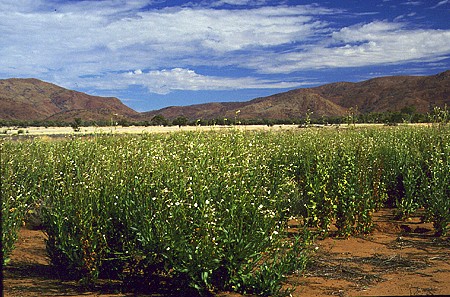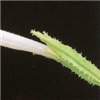
Synonymy
Nicotiana excelsior (J. Black) J. Black, Trans. & Proc. Roy. Soc. S. Austral. 50: 286 (1926);N. suaveolens var. excelsior J. Black, Trans. & Proc. Roy. Soc. S. Austral. 39: 835; t. 70 (1915).
T: Mt Carminia (now Mt Carmeena), Everard Range, S.A., 12 Aug. 1914, S.A. White s.n.; lecto: AD 97807202; iso: NSW, fide P. Horton, J. Adelaide Bot. Gard. 3: 23 (1981).
N. macrocalyx Domin, Biblioth. Bot. 89: 593; t. 36, figs 9–10 (1929).
T: Camp 19, Birksgate Range, S.A., 12 July 1891, R. Helms s.n.; holo: K n.v., photo AD; iso: AD, MEL.
Description
Leafy herb to c. 1.7 m; stems and leaves mostly glabrous, the inflorescence sparsely pubescent with non-glandular hairs.
Leaves mostly cauline, elliptic to ovate, the lower ones often obovate, the uppermost narrowly elliptic or lanceolate; lamina up to 25 cm long; lower leaves shortly petiolate, the petiole broadly winged, stem-clasping; upper leaves sessile, the base decurrent.
Inflorescence panicle-like, few-branched, the lower bracts occasionally leafy. Calyx 15–30 mm long. Corolla-tube usually 40–70 mm long, 1–5 mm wide at top of calyx; limb 20–35 mm (occasionally to 50) diam.; lobes usually obtuse. Upper 4 anthers at the same level or 2 slightly above the other 2, their filaments to 2.5 mm long; filament of the 5th stamen 6–15 mm long, inserted at middle or in lower half of corolla-tube.
Capsule ellipsoid to ovoid-ellipsoid, 12–20 mm long. Seeds reniform or acutely angled; testa usually honeycombed. n=19.
Distribution and ecology
Restricted to ranges of north-western S.A. and southern N.T. where it grows in sheltered areas in rocky gullies and creeklines.
Collections from Fraser Ra., W.A., and Mt. Lyndhurst, S.A., may not be from natural populations since the species is highly valued by Aborigines and probably dispersed by them to areas outside natural range.
Notes
An important tobacco for Aboriginal people.
See P. Latz, (1996). Bushfires and Bushtucker, Aboriginal Plant Use in Central Australia. IAD Press, Alice Springs, and D. Symon (2005) Native tobaccos (Solanaceae: Nicotiana spp.) in Australia and their use by Aboriginal peoples in The Beagle 21: 1-10, for further information on this species. Occurrence in Western Australia, remote from the main distribution of this species, is probably as a result of trade.
Selected specimens
N.T.: Mann Ranges, P.K. Latz 894 (AD, CANB, NT); Mt Olga, 12 June 1953, D.E. Symon (AD). S.A.: Ernabella, 21 May 1966, F.T. Turvey (AD).
Web links
Further information for this species in WA can be found on the FloraBase site.
A fact sheet for this species can be downloaded from the SA eFlora site.







